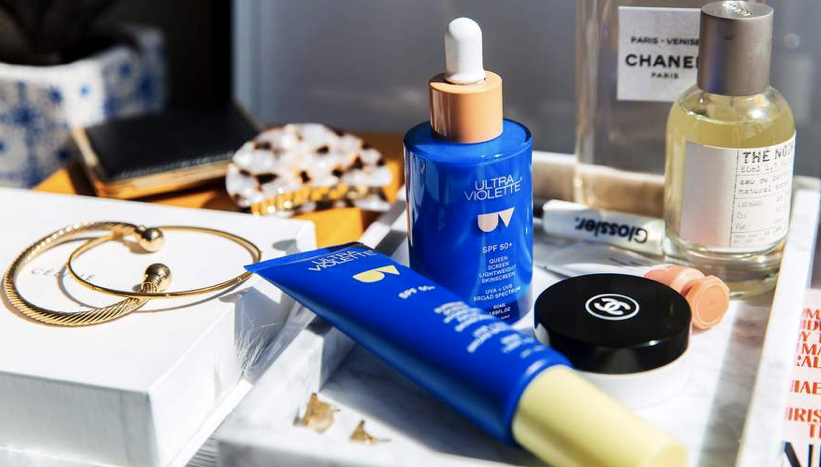In recent years sunscreen has become a confusing trend.
With a new wave of eco-conscious and organic products hitting the market, sunscreen is proving to be the new trend-driven addition to our 2019 skincare routines, vital to ensuring healthy skin and a slowing ageing process.
And while for most of us sunscreen hasn’t been a complicated issue when you’ve grown up with “slip, slop, slap” and Banana boat commercials, now more than ever, understanding what type of sunscreen to include in your daily skin care regimen can pose a litany of questions.
Do we pick a physical sunscreen over chemical sunscreen? Does natural sunscreen actually work?
Here we breakdown the differences to make choosing a sunblock easy-breezy.
PHYSICAL VS CHEMICAL
Creating a barrier between your skin and the sun, physical sunscreens work by blocking UV rays, explains skin cancer specialist Doctor Cheryl Choong. The compounds sit on the surface of your skin, creating a physical shield usually made up of zinc oxide and titanium oxide.
Physical sunblocks also tend to be more friendly to those who have sensitive skin types (All my acne prone girls give me a holler), yet are the sunscreens that sometimes leave behind that white “ghost like” cast on your face.
However, the newer physical sunscreens have come a long way containing formulas that are now micronised or tinted.
Where as a chemical sunscreen works by absorbing UVA and UVB rays converting them into heat, chemical sunscreens typically absorb into the skin and this is why they can cause allergic reactions and irritation on sensitive skin.
Combination sunscreens also exist for those wanting the best of both worlds.
Dr Choong also recommends that those who suffer from acne, eczema or rosacea avoid sunscreens that contain fragrance and oils.
SPF 15, 30, 50+ (and everything in between)
SPF refers to the sun protection factor of the product and is the measure of how well you are protected against UVB.
“SPF denotes the amount of time it takes for you to burn,” says Dr Choong.
When it comes to the SPF numbers 30+ is the recommended standard. With the higher the number, the better the protection.
For those of you who consider an SPF of 15 enough to get you by (unless you are “living in Tasmania during the winter”) the answer would be no.
INGREDIENTS TO SKIP (for the conscious minded)
If you are someone who is conscious of what you put on your skin here are some ingredients to look out for: avobenzone, oxybenzone, octinoxate, octisalate.
According to research done by the Environmental Working Group these chemicals, which are commonly found in chemical sunscreens, are considered to be endocrine-disruptors. While there isn’t enough data to determine safety limits with such chemicals, we leave the power in your hands.
So as to not avoid sunscreen at all, because protection from sun-dried skin and skin cancers is vital, this is when we introduce to you “mineral sunscreens”.
A mineral sunscreen contains a more natural formula (keep in mind all products go through chemical processes).
These sunscreens are recommended by dermatologists for those who are concerned about hormonal disruptions.
According to skin consultant Sheridan Roach: “They are the best sunscreens because they’re titanium or zinc-based.”
“Alongside avoiding oxybenzone, avoid micronised zinc and titanium as they can cause coral reef damage”, Dr Choong explains.
WATER RESISTANCE
Contrary to what your sunscreen may say no sunscreen is completely “water resistant”. When exposed to water or sweat, sunscreen will melt off.
“Sunscreens that state they are water resistant for up to four hours does not mean they will still be water resistant at the four-hour mark.”
Hence why Dr Choong says, “it’s important to re-apply every two hours” if you’re exposed to the sun for a prolonged period.
Lathering up after every swim, for all the beach babes out there, is also important.
BROAD SPECTRUM
Broad spectrum refers to protection from both UVB and UVA. So why is protection from both vital?
Well, experts at leading sunscreen research organisation the University of Iowa Health Care discern between UVB rays, that are responsible for causing sunburn, and UVA rays which cause premature ageing such as wrinkling.
More importantly, both cause skin cancers, making broad protection vital.
As Dr Choong points out: “Melanoma has a higher mortality rate for women in the 25 to 40 year old age group than breast cancer.”
SUNSCREEN RECOMMENDATIONS

Supergoop Play 100% Mineral Sunscreen Stick (Mineral)
Containing antioxidants and chia seed oil, this Supergoop stick is hydrating and an easy blend, perfect for those always on-the-go. With a broad spectrum SPF of 50, it’s become a classic for mothers, children and everyone in between.
 Sun Bum Original Sunscreen Lotion SPF 50 (Chemical)
Sun Bum Original Sunscreen Lotion SPF 50 (Chemical)
Sun Bum, has quickly become my all time go to. Enriched with Vitamin E and antioxidants that help neutralise free radicals, a main cause for premature ageing. While it is a chemical sunscreen, one thing to note is that this sunscreen is oxybenzone and octinoxate free. It’s also vegan.
(P.S. they also do a mineral sunscreen! We’ve got you covered).

Supreme Screen SPF 50+ Hydrating Facial Sunscreen Ultra Violette (Chemical)
Ultra Violette, an Australian brand, has become a new cult classic because of its non-offensive formula. Made with Kakadu Plum this chemical sun block contains no trace of oxybenzone and is perfect to layer underneath your makeup. It’s considered an all-in-one sunscreen and primer!

Umbra Sheer Physical Daily Defense, Drunk Elephant (Physical)
This anti-ageing natural sunscreen is loaded with antioxidants such as grape juice and infused with Marla oils and raspberry seed. A perfect combatant against photoaging. Umbra Sheer is a go to for sensitive skin gals because of its silicone free formula.


